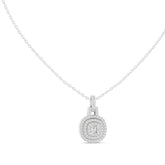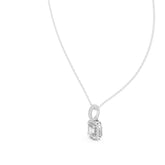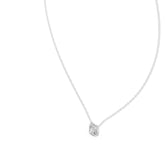Below are frequently asked questions by our customers before purchasing jewelry.
If you have any further questions, please
Send them to: ijeweler@icloud.com
- All
- Natural diamonds, laboratory diamonds, and moissanite
- General jewelry FAQs
- Sizes: rings, necklaces, and bracelets
Need help?
If you have a problem or question that requires immediate help, you can click the button below to speak with a customer service representative.
If we are not available, send us an email and we will get back to you within 20-36 hours!
Natural diamonds, laboratory diamonds, and moissanite
Natural diamonds: formed over billions of years under high pressure and temperature conditions deep in the earth's crust.
Laboratory Diamonds: Created in a laboratory environment using High Pressure and Temperature (HPHT) or Chemical Diffusion (CVD) methods to mimic the natural diamond formation process.
Moissanite: First discovered in meteorites and now synthetically produced in laboratories, made from silicon carbide.
Natural diamonds: Known for their unique inclusions and natural growth patterns.
Laboratory diamonds: visually identical to natural diamonds, but may display different inclusion patterns and growth structures under microscopic examination.
Moissanite: Shows more intense sparkle and fire (flashes of colored light) than diamonds, which can make it look different than diamonds in certain lighting conditions.
Natural diamonds: usually the most expensive due to their rarity and the cost of mining.
Lab Diamonds: Generally cheaper than natural diamonds because they are less rare and cheaper to manufacture.
Moissanite: significantly cheaper than both natural and lab-grown diamonds, making it a cost-effective alternative.
Natural diamonds: Mining can cause significant environmental impacts and ethical issues, such as conflict diamonds.
Laboratory diamonds: considered more ethical and environmentally friendly, since there is no need for mining and they can be produced using renewable energy sources.
☞ Moissanite: It is also ethical and environmentally friendly, as it is created entirely in a laboratory without the need for mining.
Natural diamonds: the hardest natural material known, with a hardness of 10, making them extremely durable.
Laboratory diamonds: Difficulties and durable as much as natural diamonds, with a mosh hardness of 10.
Moissanite: slightly less hard with a mosh hardness of 9.25, but still very durable and suitable for everyday wear.
Natural diamonds: it is difficult to distinguish them from laboratory diamonds and moissanite without special equipment.
Laboratory diamonds: do not look different from natural diamonds to the naked eye, but they can be identified through special tests.
Moissanite: It can be distinguished by its high luster and fire, but close inspection and comparison is necessary to be sure.
Natural diamonds: graded according to the four Cs: carat weight, cut, color, and clarity.
Laboratory diamonds: graded according to the same standards as natural diamonds (the four Cs).
Moissanite: Graded primarily by color, clarity and cut, with less emphasis on carat weight due to its lower price.
Budget: Determine how much you are willing to spend. Natural diamonds tend to be the most expensive, while laboratory diamonds offer similar qualities at a lower price. Moissanite provides a beautiful and cheaper alternative.
Ethics and Sustainability: If environmental impact and ethical sourcing are important to you, lab diamonds and moissanite are excellent choices. Lab diamonds avoid environmental and ethical issues associated with mining, and moissanite is created entirely in a lab.
Symbolism and Tradition: If the symbolic and traditional aspects of a natural gemstone are important to you, natural diamonds may be the preferred choice. They carry with them a legacy of a classic symbol of luxury and commitment.
Appearance and Gloss: Consider the visual features you want. Moissanite is known for its extraordinary luster and light, sometimes sparkling more than diamonds. Natural diamonds and laboratory diamonds offer a classic diamond look with a familiar shine.
Durability: All three options are durable and suitable for daily wear. Natural diamonds and laboratory diamonds have a hardness of 10 on the Mohs scale, which makes them very resistant to scratches. Moissanite, with a hardness of 9.25, is also very durable.
Personal values: Think about what is most important to you in a gemstone. If you appreciate natural rarity and the history behind a natural diamond, this may guide your choice. If innovation, sustainability and modern technology appeal to you, lab diamonds or moissanite may be more attractive.
Each type of gemstone has its own unique benefits, ensuring that every customer can find the perfect match according to their priorities and values.
General jewelry FAQs
A: White gold, yellow gold, and red gold all start with pure gold but differ in their alloy composition, color, appearance, and maintenance needs. Here is a breakdown of the main differences between them:
Color and appearance:
White gold: Created by alloying pure gold with white metals such as platinum, nickel, or silver. It is sometimes plated with rhodium to enhance its white-silver appearance, which gives it a modern and smooth appearance.
Yellow gold: retains its natural warm yellow hue by alloying pure gold with metals such as copper and zinc. This gives it a classic, rich and traditional look.
Red Gold: Achieved by alloying pure gold with copper. The more copper, the deeper the shade of pink or red, giving it a warm and romantic look.
Alloy composition:
White gold: usually includes platinum, nickel, or silver, in addition to rhodium plating to improve shine and durability.
Yellow gold: an alloy with copper and zinc, maintains the natural gold color while adding durability.
Red gold: Contains a significant amount of copper, which gives it its distinctive rose-red color.
resistance:
White gold: durable due to the hardness of the alloy metals and the protective rhodium coating. However, the rhodium plating may wear off and may need to be renewed.
Yellow gold: durable but slightly softer than white gold. Requires less maintenance as it does not have a coating that may rub off.
Red gold: durable due to the copper content, which makes it harder than yellow gold. No coating is needed, so it requires minimal maintenance.
Popularity and Style:
White gold: preferred for modern and contemporary designs due to its smooth and flexible appearance.
Yellow Gold: Preferred for its classic and traditional appeal, sometimes seen in classic and vintage designs.
Red gold: popular for its unique and romantic look, attracts those who appreciate a unique and fashionable style.
A: To keep your jewelry in its best condition, store it in a safe place, clean it regularly with a mild detergent, and avoid exposing your jewelry to strong chemicals or extreme conditions.
A: The four Cs are carat (weight), cut (shape and quality of cut), color (whiteness), and cleanliness (absence of inclusions and defects). These features determine the quality and value of the diamond.
A: Distinguishing between natural and synthetic gemstones often requires special equipment and testing by a qualified gemmologist. Look for certificates and present questions to the diamond about the origin of the stone.
A: A good idea is to check your jewelry at least once a year for damage or wear, especially for items that are worn daily.
A: Yes, we adhere to the Kimberley process and only receive diamonds from trusted suppliers who guarantee they are conflict free.
A: Yes, we provide comprehensive descriptions for each piece of jewelry, including information about the metal type, stone details (such as carat weight, cut, color, and clarity), and general design features. These detailed descriptions can be used for various purposes, including verifying authenticity, understanding the value, and presenting to insurance companies for the purpose of insuring the item. Our descriptions ensure you have all the information required to protect and enjoy your precious jewelry
A: Yes, we recommend insuring expensive jewelry to protect against loss, theft or damage. You can add jewelry to your home insurance or renter's insurance, or get a separate jewelry insurance policy.
Sizes: rings, necklaces, and bracelets
A: Your ring size can be measured using several methods:
Option 1: Ring Sizer: Use a ring sizer available at jewelry stores or online.
Option 2: Measuring an existing ring: Measure the inside diameter of a ring that fits your finger.
Option 3: Measuring your finger: Use a printable ring size chart to measure the circumference of your finger.
A: It is generally recommended to choose the larger size for comfort, especially if the ring is wide or has a thick band.
A: Chain lengths are generally classified as follows:
Shocker (35.5-40.5 cm / 14-16 inches): sits snugly around the neck.
Princess (45.7 cm / 18 inches): falls slightly below the collarbone.
Inseam (50.8-61 cm / 20-24 inches): Depends on the upper bust line.
Oprah (71-91.4 cm / 28-36 inches): Long length that can be worn as a single or double strap.
A: Measure your wrist with a flexible measuring tape or string under the wrist bone. Add about four to five cm for comfort, depending on how tight or loose you prefer the bracelet.
A: Standard bracelet sizes generally range from:
Small: about 16.5 cm (6.5 inches)
Medium: About 17.8 cm (7 inches)
Large: about 20.3 cm (8 inches)
These sizes may vary slightly depending on the jewelry brand or design. There are also custom arrangement options according to your preference.
A: Bracelets with adjustable links or designs can be easily adjusted by adding or removing links. For bracelets without the possibility of adjustment or with rigid designs, the adjustment may be more complex and require professional assistance from the diamond.
It is always recommended to consult a diamond for accurate measurements and adjustments to ensure your bracelet fits comfortably and complements your style.
These size guides provide essential information to help you choose the right bracelet size and understand the fit options for your jewelry.






